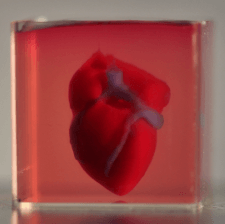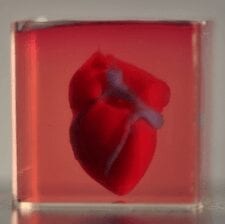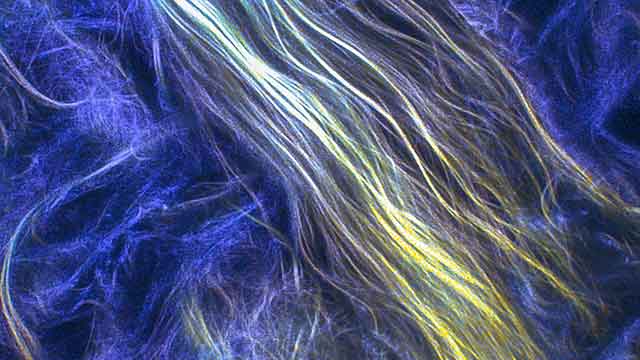
Engineered heart completely matches the immunological, cellular, biochemical and anatomical properties of the patient
In a major medical breakthrough, Tel Aviv University researchers have “printed” the world’s first 3D vascularised engineered heart using a patient’s own cells and biological materials. Their findings were published on April 15 in a study in Advanced Science.
Until now, scientists in regenerative medicine — a field positioned at the crossroads of biology and technology — have been successful in printing only simple tissues without blood vessels.
“This is the first time anyone anywhere has successfully engineered and printed an entire heart replete with cells, blood vessels, ventricles and chambers,” says Prof. Tal Dvir of TAU’s School of Molecular Cell Biology and Biotechnology, Department of Materials Science and Engineering, Center for Nanoscience and Nanotechnology and Sagol Center for Regenerative Biotechnology, who led the research for the study.
Heart disease is the leading cause of death among both men and women in the United States. Heart transplantation is currently the only treatment available to patients with end-stage heart failure. Given the dire shortage of heart donors, the need to develop new approaches to regenerate the diseased heart is urgent.
“This heart is made from human cells and patient-specific biological materials. In our process these materials serve as the bioinks, substances made of sugars and proteins that can be used for 3D printing of complex tissue models,” Prof. Dvir says. “People have managed to 3D-print the structure of a heart in the past, but not with cells or with blood vessels. Our results demonstrate the potential of our approach for engineering personalized tissue and organ replacement in the future.”
Research for the study was conducted jointly by Prof. Dvir, Dr. Assaf Shapira of TAU’s Faculty of Life Sciences and Nadav Moor, a doctoral student in Prof. Dvir’s lab.
“At this stage, our 3D heart is small, the size of a rabbit’s heart,” explains Prof. Dvir. “But larger human hearts require the same technology.”
For the research, a biopsy of fatty tissue was taken from patients. The cellular and a-cellular materials of the tissue were then separated. While the cells were reprogrammed to become pluripotent stem cells, the extracellular matrix (ECM), a three-dimensional network of extracellular macromolecules such as collagen and glycoproteins, were processed into a personalized hydrogel that served as the printing “ink.”
After being mixed with the hydrogel, the cells were efficiently differentiated to cardiac or endothelial cells to create patient-specific, immune-compatible cardiac patches with blood vessels and, subsequently, an entire heart.
According to Prof. Dvir, the use of “native” patient-specific materials is crucial to successfully engineering tissues and organs.
“The biocompatibility of engineered materials is crucial to eliminating the risk of implant rejection, which jeopardizes the success of such treatments,” Prof. Dvir says. “Ideally, the biomaterial should possess the same biochemical, mechanical and topographical properties of the patient’s own tissues. Here, we can report a simple approach to 3D-printed thick, vascularized and perfusable cardiac tissues that completely match the immunological, cellular, biochemical and anatomical properties of the patient.”
The researchers are now planning on culturing the printed hearts in the lab and “teaching them to behave” like hearts, Prof. Dvir says. They then plan to transplant the 3D-printed heart in animal models.
“We need to develop the printed heart further,” he concludes. “The cells need to form a pumping ability; they can currently contract, but we need them to work together. Our hope is that we will succeed and prove our method’s efficacy and usefulness.
“Maybe, in ten years, there will be organ printers in the finest hospitals around the world, and these procedures will be conducted routinely.”
Learn more: TAU Scientists Print First 3D Heart Using Patient’s Own Cells and Materials
The Latest on: 3D vascularised engineered heart
[google_news title=”” keyword=”3D vascularised engineered heart” num_posts=”10″ blurb_length=”0″ show_thumb=”left”]
via Google News
The Latest on: 3D vascularised engineered heart
- Best 3D printers for 2024on May 5, 2024 at 10:54 pm
The best 3D printers allow you to make all sorts of interesting things from small parts to finished products right from the comfort of your home. However, finding the right 3D printer for your ...
- The Best Cheap 3D Printers for 2024on May 5, 2024 at 5:00 pm
Today's affordable 3D printers will likely surprise you: You can get a smooth-working machine with features once found only in high-end models. Check out the top-performing cheap 3D printers we've ...
- The Best 3D Printers for 2024on May 1, 2024 at 5:00 pm
More affordable than ever, 3D printers are booming for personal, professional, and educational use. Here's everything to know before you buy one, along with the top models from our hands-on testing.
- Transplantation of Engineered Heart Tissue as a Biological Cardiac Assist Device for Treatment of Dilated Cardiomyopathyon April 17, 2024 at 5:00 pm
Eur J Heart Fail. 2013;15(1):23-35. However, relaxation parameters and end-diastolic diameter were similar among both DCM groups, except that under dobutamine stimulation relaxation was impoved in ...
- 3D engineered tissues as disease modelson April 15, 2024 at 5:00 pm
To promote this exciting field, Communications Biology welcomes submissions that contribute to highlighting the recent advances in the development of engineered 3D disease models and how they can ...
- Figure 5 (IMAGE)on August 14, 2021 at 6:34 am
Caption miR-151a enhances angiogenesis in 3D vascularized lung tumor spheroids and is expressed in vasculature of NSCLC patient specimens. (A) Stable miR-modulated (GFP-expressing miR control, miR ...
- 3D Printed Mini MacBook With A Raspberry Pi Hearton October 7, 2020 at 10:08 pm
Are you a fan of the Raspberry Pi? Have a particular affinity for hot glue and 3D printed plastic? Then you’re in luck, because this tiny “MacBook” built by serial miniaturizer [Michael Pick ...
via Bing News











